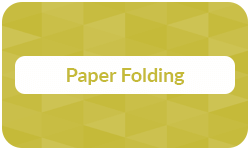
Paper folding plays a key role in how printed materials are presented and used. Whether it’s a brochure, invitation, or mailer, the type of fold can shape how information is experienced. It helps organise content, adds structure, and can even influence first impressions. In marketing and design, a well-chosen fold adds both function and flair. This guide highlights the most common fold types used in printing today.
Inhaltsverzeichnis
Definition: Paper folding
Paper folding is the process of bending a printed sheet into a specific shape or layout to serve a functional or design purpose. It is commonly used in commercial printing to create brochures, mailers, invitations, menus, and other marketing materials.
In printing, folding helps organise content, improve presentation, and guide the reader’s attention, making it an essential element in effective print design.
This type of folding is different from decorative or artistic paper folding, such as origami (折り紙), the traditional Japanese art of folding paper into intricate shapes without cutting or gluing.
Your guide to print and production
- Information on print finishing & print processing
- Information on materials & optimal use of materials
- Information on printing processes & print production
Learn more!
Common types
There are many ways to fold paper, each with its own purpose and effect. Some folds are simple and classic, while others are more complex and eye-catching. The choice of fold depends on the format, content, and desired user experience. Below are the most commonly used fold types in printing.
The C-fold, also called the letter fold, divides the paper into three equal panels, folded inward so one panel tucks inside. Viewed from the side, it resembles the letter “C.” It’s commonly used for brochures and letters that fit into standard envelopes.

The Z-fold divides the sheet into three equal panels that fold in alternating directions, forming a zigzag shape. Viewed from the side, it looks like the letter “Z.” This fold is popular for brochures, mailers, and flyers that need to unfold in sequence for easy reading or display.

The tri-fold is similar to the C-fold but doesn’t always require equal panel widths. It divides the paper into three sections, with two folds creating a compact layout. This fold is common for brochures and menus, offering a step-by-step reading flow and convenient handling.

A gate fold features two end panels that fold inward to meet in the center without overlapping, like a pair of gates. It opens up to reveal a larger central panel, making it ideal for impactful designs, invitations, or promotional materials that benefit from a dramatic reveal.

The accordion fold creates a zig-zag shape with multiple parallel folds that alternate direction. Each panel folds in the opposite direction of the previous one, making it easy to expand and collapse. It’s well-suited for timelines, step-by-step guides, and visual storytelling.

Also known as the cross fold, the French fold involves folding a sheet in half vertically and then again horizontally. This creates four panels of equal size. It’s commonly used for greeting cards, event programs, or inserts that require compact delivery and unfolding.

In a double parallel fold, the sheet is first folded in half, then folded again in the same direction, creating four panels. This fold is useful for longer content, such as instructional brochures or manuals, as it provides a clear, linear reading path.

A roll fold involves folding each panel inward over the next, rolling in from one end to the other. This creates a compact and layered format, often used for step-by-step instructions, product features, or multi-part promotions that reveal content gradually.

The half fold, or single fold, is the most basic folding method. The sheet is simply folded once down the center, creating two equal panels. It’s often used for greeting cards, booklets, or simple programs where minimal structure is needed.

If you’d like to know which folded printer paper fits into which envelope, click the button below.
Printing services at BachelorPrint
- Individual solutions & personal support
- High print quality & fast production times
- Wide range of print products for every need
Learn more!
Choosing the right fold
The right paper fold depends on your content, design, and purpose. Consider how much information you need to include, how you want it to be revealed, and the user experience you’re aiming for. Some folds are best for storytelling, while others suit formal communication or promotional use. Your print provider can also help you choose the best option for your project.
Fold type
Best for
Content length
Design impact
Fits in envelope
C fold
Medium
Moderate
✅ Yes
Tri fold
Medium
Moderate
✅ Yes
Gate fold
Short – Medium
High
⚠️ Often custom
Accordion fold
Medium – Long
Medium
⚠️ Sometimes
French fold
Short
Low – Moderate
✅ Yes
Double parallel fold
Long
Low – Moderate
⚠️ Sometimes
Roll fold
Long
High
⚠️ Sometimes
Half fold
Short
Low
✅ Yes
FAQs
Paper folding in printing refers to the process of bending printed sheets into specific formats, like brochures or mailers, to enhance usability and presentation.
Yes, it’s also called “document folding” or simply “folding” in the printing industry. In a different context, especially the artistic folding of paper, it’s known as origami (折り紙) in Japanese.
Theoretically, yes. Due to exponential growth in thickness with each fold. But practically, it’s impossible with regular paper.
With standard paper and human strength, it’s very hard. However, with large, thin sheets and tools, people have folded paper more than 8 times.
Each fold doubles the thickness and reduces the foldable area, making it increasingly harder to fold further.